Creative GigaWorks S750 Speaker System Review: Beyond Ultra Sound

Today we are going to take a closer look at an outstanding classy 7.1 speaker system, which hardly has any rivals in the sector of multimedia systems. If you are looking for the best most delicious sounding, it is your choice!
Today there are numerous models of multimedia speaker systems for any taste and liking in shops, making it easy to get confused and pass by something really exceptional. Systems from Creative, however, developed by the Cambridge SoundWorks acoustic laboratory, can captivate any idle shopper who is wandering around a computer supermarket.
We are going to test the Creative GigaWorks S750 speaker system today, which is attractive due to both: its exclusive design and the list of technical characteristics, which accompanies each product in a shop.
What’s so attractive about the characteristics? Let’s read them first!
Creative GigaWorks S750: Technical Characteristics
| Overall frequency response | 25Hz – 40kHz |
| Signal-to-Noise ratio (SNR) | 99dB |
| Satellite power | 70W RMS per channel (70x7) |
| Satellite diffuser diameter | 3”-midwoofer, 1”-tweeter |
| Subwoofer power | 210W RMS |
| Subwoofer diffuser diameter | 8” |
| Subwoofer dimensions | 315mmx315mmx315mm |
| Approximate price | $400 |
The main parameter is highlighted red in the table: the Creative GigaWorks S750 can reproduce the audiophile frequency range, unlike ordinary multimedia speaker systems. Besides that, the system is endowed with high power, comes with a large subwoofer with a big-diameter diffuser and has double-band satellites. This is all very good, but an average customer may be disappointed having reached the last row of the table above. On the other hand, the price seems adequate to the product if we consider it seriously. You can divide the total price of the system by eight (speakers) and subtract the cost of the amplifier, accessories (like the control unit, wires and so on) to reach a very modest price of around $40 per unit. The GigaWorks S750 may be an excellent choice for building an astonishing home theater based around your personal computer. Just don’t overstrain yourself, carrying this system home. 🙂
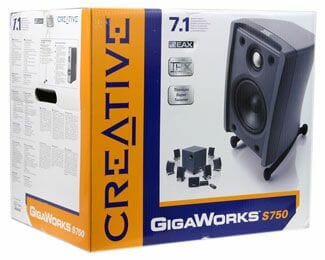
According to the text on the package (its dimensions: 44x51x57cm), the weight of the system is 28.5kg. Let’s see what we have inside.
Product and Accessories
You will find numerous components and accessories to the GigaWorks S750 speaker system in the box. Everything is neatly packed to fit into the room. So, when buying this system you receive:
- Seven double-band satellites with desktop stands and wall fastenings;
- Subwoofer;
- Audio Control Pod;
- Infrared remote control;
- Cables;
- User’s manual.
The following section of the review deals with the construction of the system components and its accessories.
Design
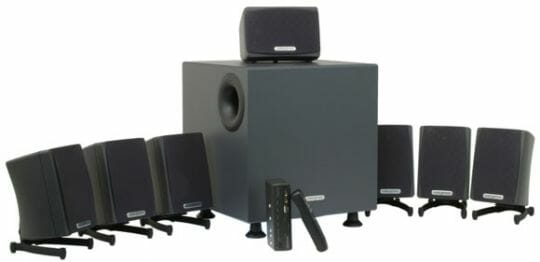
So, the GigaWorks S750 system includes seven satellites, a subwoofer, an Audio Control Pod and a remote control unit. Each satellite comes with a rubber-soled desktop stand. To wall-mount the satellites, you use the slit at their rear panels for the screw head (the cutter and dowels are included with the system). All the satellites are equipped with clamps that clench the signal wires – that’s a sign of classy acoustics. Their polarity is marked with red cambric, for the user not to be wrong about the phase during their attachment. The lengths of the wires are specifically tailored for each pair of satellites: 2m for the front pair and the central channel, 5m for the middle pair and 7m for the rear speakers. The signal wires from the satellites are attached to the sockets at the subwoofer rear panel. There are special stickers included with the speakers for you not to get lost in this heap of cables.
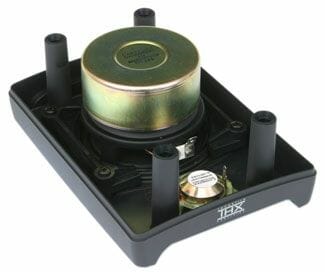
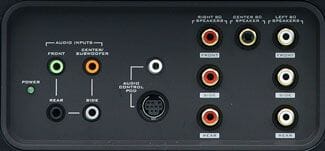
The satellites of the system are equipped with two speakers: a mid-woofer (middle frequencies) with a diffuser of 3” in diameter and an input resistance of 8 Ohms, and a high-frequency 1-inch 4Ohm tweeter. There is a crossover board inside each satellite and the volume of the case is filled with synthetic wool.
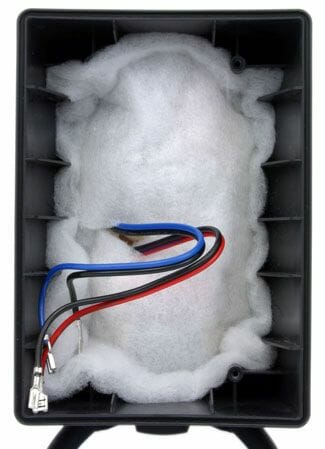
I’d like to draw your attention to the construction of the tweeter. It is the first time Creative uses a high-frequency speaker of the dome type with a titanium membrane in its satellites. Titanium adds rigidity to the membrane, allowing to fully embrace the range of high frequencies and the ultrasound range. That’s why the manufacturer proudly wrote down the audiophile range of 25Hz-40kHz in the specification.
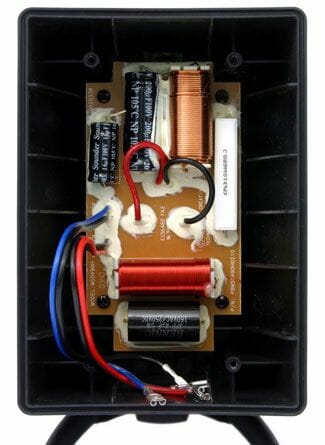
The mid-range speaker has improved since the one of the MegaWorks 510D. Its soft hanger is made of foam rubber. The diffuser is now made of plastic rather than of treated cardboard.
The central-channel satellite doesn’t differ from the others, save for the contraption for horizontal placement. The cases of all the satellites are made of special dark-color stiff plastic that protects against magnetic fields. The outward solidity is achieved by means of the removable lid wrapped with cloth and carrying the Creative logotype. Well, if you remove it, opening the access to the diffusers, the satellite won’t lose its good looks.
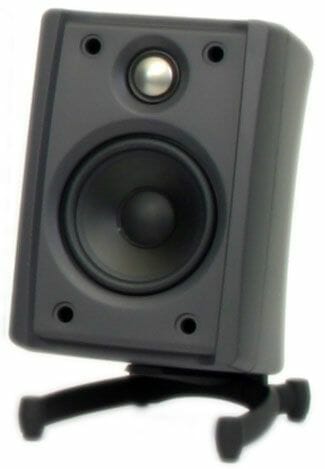
Now, let’s consider the low-frequency unit. The subwoofer differs from the one of the MegaWorks 510D system in the type of the acoustic enclosure. This time the manufacturer stepped away from the closed scheme and equipped the box with a phase-inverter port. By the way, the internal part of the port is covered with a net that prevents external things from getting into the case. The low-frequency 8” speaker is targeted at the floor and is also protected with a metal grid. Overall, the employed acoustic enclosure of the subwoofer produces an enveloping and deep bass of high power for that size of the box. I could clearly hear that when listening to the system.
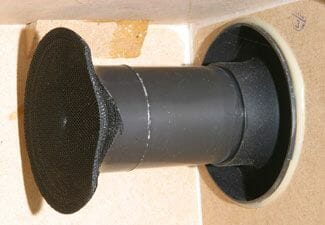
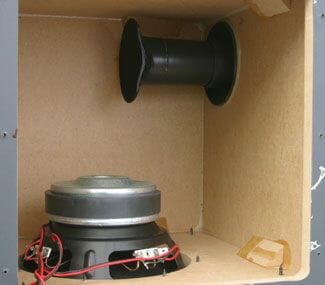
The box itself is rather large (315x315x315mm); it stands on legs with soft-rubber pads. Besides the big diffuser, the subwoofer case contains PCBs of the power unit and the digital amplifier on powerful field transistors made by the patented B.A.S.H. technology (Bridged Amplifier Switching Hybrid). For the story about the subwoofer to be complete, I took it apart. After removing the rear metal panel I found that the electronics parts fastened to it took up a big portion of the box. To minimize the bounce of the inter-case components, they are all additionally fastened and the wire junctions are covered with a special gluing material. The electrolytic capacitors and throttles towering over the PCBs are coated with this material, too.
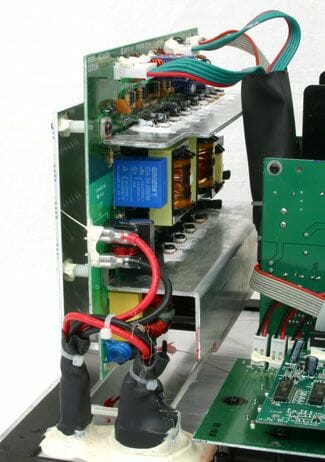
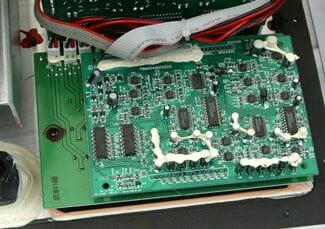
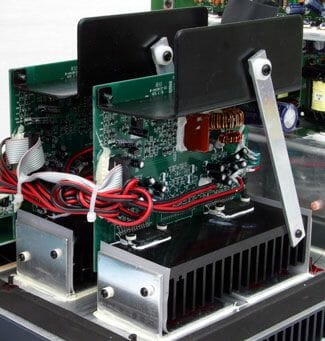
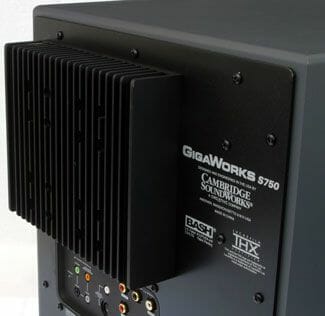
The rear panel of the subwoofer case is equipped with a big heatsink grid. The panel carries connectors for attaching the satellites of the system, line-in sockets for the audio card and a couple of connectors for the external switch unit called Audio Control Pod. Somewhere to a side, there are a power plug and a power button. Regrettably, the Creative GigaWorks S750 doesn’t have an additional digital input, so you only have to connect it to the audio card using the analog outputs.
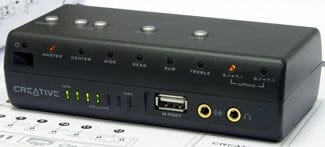
The Creative GigaWorks S750 system includes an Audio Control Pod, a unit for controlling the system and communicating with the remote control. The Pod has a hole of the infrared receiver in the front panel exactly for that purpose.
The discrete digital-tuning scale consists of numerous tiny steps. At the same time, there is only a row of seven LEDs indicating the volume level and the timbre (and the first LED is always aglow). It’s not important for varying the volume level, while the timbre adjustment seems rather cumbersome. By the way, all the control functions are duplicated on the remote control unit.
You can see in the snapshot of the Pod that its front panel has a USB port labeled M-PORT. This connector is here to extend the system communication capabilities, for linking it to other audio devices from Creative, equipped with such ports. The Pod also has a headphones socket and a Line-in connector. Considering that you usually have to unplug the front output of the speaker system to attach your headphones, the placement of the additional socket on the external Pod seems reasonable.

You turn the system on either from the Pod or from the remote control unit. Note that the engineers of the Cambridge SoundWorks laboratory improved the electronic circuitry compared to the MegaWorks 510D and you don’t hear loud clicks on powering the system up, as before.
Testing
I guess you have formed your own opinion about the design of the GigaWorks S750, so it’s time to check out this system in practice. As usual, I used a special IASCA Competition CD with 37 test audio tracks. This audio CD is universal and serves to evaluate objective parameters (it has tracks with “pink noise”, the maximum sound pressure and so on), but also helps to form a subjective impression. The tracks fall into several categories, depending on the evaluated sound characteristic (voice frequency, spectrum balance, sound scene and so on). Many records are taken from well-known music archives like Telarc, Clarify, Reference, Sheffield and Mapleshade.
I attached the speaker system to two audio cards in my tests, Creative Audigy2 ZS and Creative E-MU 1820. When evaluating the acoustic parameters, we took the signal of the test CD right from the line-out out of the optical DVD drive. Then we used a Euraudio PRO600S audio-analyzer with an external calibrated microphone to measure the gain-frequency characteristic of the speaker system by the sound pressure in real time.
I should confess that listening to the GigaWorks S750 was really an enjoyable experience. First of all, I’d like to mention the excellent power reserve of the system. It seemed to be just unable to release all its potential in the room of our test laboratory. When reproducing SPL Competition audio track, the sound pressure level was 110.1dB and the maximum, peak level was 114.2dB. By the way, no living being suffered from my tests – I performed them on a weekend, when no one else was in our lab.
Mostly due to the employed type of the acoustic enclosure, the system gave out a good bass with a solid foundation and clear structure. The drums sounded crisp and stiff. The system as if breathed trying to represent the bass instruments truly.
The screenshot below shows the frequency range of the subwoofer during the playback of the “pink noise” test track.
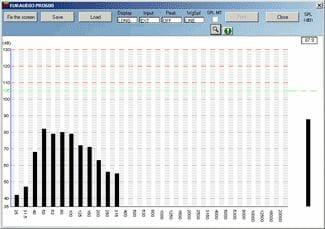
The linearity of the system was up to the mark, too. To examine this parameter, I used three identical test fragments, recorded with peak sound pressure levels of 81, 93 and 105dB. The volume level was set up depending on the data of the audio-analyzer. I should note that a majority of multimedia systems I have ever tested expose a linearity distortion, especially when reproducing the 105dB-SPL fragment.
The excellent satellites contributed much to the crystal-pure voice of the system; they fully embrace the range of middle and high frequencies, while positioning of the sound source is recognizable along the entire stereo panorama. The measured gain-frequency characteristic confirms my words.
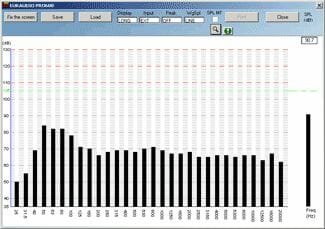
The screenshot tells you that the misbalance of the gain-frequency characteristic doesn’t exceed 5dB in this range; the spectrum is even, without any slumps. As a result, the system boasts a good timbral balance. The realistic and emotional sound of classical music testifies to the well-placed accents of forte and piano. The system is careful about the genres: jazz sounds expressive, while rock explodes the volume, making you perceive the typical distortions of such music. Well, even trite pop compositions are not as annoying as they would be on a cheap speaker system! 🙂
| Actual (measured) frequencies range | ~31.5Hz-20kHz* |
| Relative unevenness of the gain-frequency characteristic in the 50Hz-15kHz frequency range | ~5dB |
| Threshold frequency for the satellites | ~400Hz |
| Maximum sound pressure (SPL) | ~114.2dB |
Regrettably, our audio-analyzer doesn’t hear anything above 20,000Hz, so I just couldn’t honestly put 40kHz in the first line of the table.
Conclusion
So, the Creative GigaWorks S750 passed all our tests with honors – I only have to add a few words in conclusion. When the system reproduced wide ranges of middle and high frequencies, it proved highly demanding to the audio card installed in the system. A majority of standard widely spread sound cards stress your ears at high frequencies, spoiling those frequencies altogether. It was about the same with a Creative Audigy2 ZS card. The titanium tweeter is the one to blame here, as it was conscientiously reproducing everything, including high-frequency noise. We could only enjoy the new speaker system with the newest Creative E-MU 1820 card which happened to be in our test lab at the moment. With that card, the GigaWorks S750 not just sounded, it gave out a delicious sound! Thus, if you are considering this speaker system, you should think about the installed sound card in advance, too. Otherwise, you may be disappointed.
Creative GigaWorks S750 is undoubtedly a classy speaker system and I think it has no rival today in the sector of multimedia systems. If you go for the best, it’s yours! Just come and get it!
Highs:
- Wide range of reproduced frequencies with a low gain-frequency characteristic dispersion;
- High sound pressure levels;
- Excellent sound quality;
- Easy system management;
- A comprehensive user’s manual;
- No clicks when the system powers up.
Lows:
- No digital input (like one in the MegaWorks 510D);
- No floor stands for the surround satellites;
- Inter-case elements of the subwoofer resound during reproduction of certain frequencies;
- Requires a high-quality audio output of the sound card;
- Indication of volume levels is too primitive.